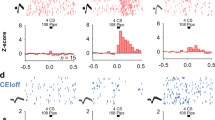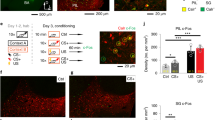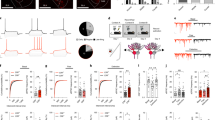Abstract
Fear-arousing stimuli elicit innate reactions and can reinforce acquisition of new responses. We tested whether mechanisms mediating these conditioned stimulus (CS) properties were isomorphic or dissociable within the amygdala. Rats trained on a fear-conditioning task (CS paired with footshock) were then trained on an escape-from-fear task (EFF) in which the CS reinforced a locomotor response terminating the CS. Lateral nucleus (LA) lesions blocked acquisition of both conditioned freezing responses and the CS's reinforcement of a new response in the EFF task. Central nucleus (CE) lesions blocked conditioned freezing but not the EFF, whereas basal nucleus (B) lesions blocked the EFF but not conditioned freezing. Thus, activation of the LA by a CS seems to trigger conditioned reactions via CE and conditioned aversion via B activation, reduction of which reinforces new actions.
This is a preview of subscription content, access via your institution
Access options
Subscribe to this journal
Receive 12 print issues and online access
$209.00 per year
only $17.42 per issue
Buy this article
- Purchase on Springer Link
- Instant access to full article PDF
Prices may be subject to local taxes which are calculated during checkout





Similar content being viewed by others
References
Blanchard, R. J. & Blanchard, D. C. Defensive reactions in the albino rat. Learn. Motivat. 2, 351–362 (1971).
Bolles, R. C. Reinforcement, expectancy, and learning. Psychol. Rev. 79, 394–409 (1972).
McAllister, W. R. & McAllister, D. E. in Aversive Conditioning and Learning (ed. Brush, F. R.) 105– 179 (Academic, New York, 1971).
Miller, N. E. Studies of fear as an acquirable drive: I. Fear as motivation and fear reduction as reinforcement in the learning of new responses. J. Exp. Psychol. 38, 89–101 ( 1948).
LeDoux, J. E. Emotion circuits in the brain. Annu. Rev. Neurosci. 23 155–184 (2000).
Davis, M. The role of the amygdala in emotional learning. Int. Rev. Neurobiol. 36, 225–266 ( 1994).
Maren, S. & Fanselow, M. S. The amygdala and fear conditioning: has the nut been cracked? Neuron 16, 237 –240 (1996).
LeDoux, J. E., Cicchetti, P., Xagoraris, A. & Romanski, L. M. The lateral amygdaloid nucleus: Sensory interface of the amygdala in fear conditioning. J. Neurosci. 10, 1062– 1069 (1990).
LeDoux, J. E., Iwata, J., Cicchetti, P. & Reis, D. J. Different projections of the central amygdaloid nucleus mediate autonomic and behavioral correlates of conditioned fear. J. Neurosci. 8, 2517 –2529 (1988).
Walker, D. L. & Davis, M. Double dissociation between the involvement of the bed nucleus of the stria terminalis and the central nucleus of the amygdala in startle increases produced by conditioned versus unconditioned fear. J. Neurosci. 17, 9375– 9383 (1997).
Campeau, S. & Davis, M. Involvement of the central nucleus and basolateral complex of the amygdala in fear conditioning measured with fear-potentiated startle in rats trained concurrently with auditory and visual conditioned stimuli. J. Neurosci. 15, 2301 –2311 (1995).
Roozendaal, B., Koolhaas, J. M. & Bohus, B. Central amygdala lesions affect behavioral and autonomic balance during stress in rats. Physiol. Behav. 50, 777–781 (1991).
Kapp, B. S., Frysinger, R. C., Gallagher, M. & Haselton, J. Amygdala central nucleus lesions: effect on heart rate conditioning in the rabbit. Physiol. Behav. 23, 1109– 1117 (1979).
Everitt, B. J. & Robbins, T. W. in The Amygdala: Neurobiological Aspects of Emotion, Memory and Mental Dysfunction (ed. Aggleton, J. P.) 401–430 (Wiley, New York, 1992).
Killcross, S., Robbins, T. W. & Everitt, B. J. Different types of fear-conditioned behavior mediated by separate nuclei within amygdala. Nature 388, 377–380 (1997).
Pitkänen, A., Savander, V. & LeDoux, J. L. Organization of intra-amygdaloid circuitries: an emerging framework for understanding functions of the amygdala. Trends Neurosci. 20, 517–523 (1997).
Amaral, D. G., Price, J. L., Pitkänen, A. & Carmichael, S. T. in The Amygdala: Neurobiological Aspects of Emotion, Memory, and Mental Dysfunction (ed. Aggleton, J. P.) 1–66 (Wiley-Liss, New York, 1992).
McDonald, A. J. Cortical pathways to the mammalian amygdala. Prog. Neurobiol. 55, 257–332 (1998).
Turner, B. & Herkenham, M. Thalamoamygdaloid projections in the rat: a test of the amygdala's role in sensory processing. J. Comp. Neurol. 313, 295–325 (1991).
Mascagni, F., McDonald, A. J. & Coleman, J. R. Corticoamygdaloid and corticocortical projections of the rat temporal cortex: a phaseolus vulgaris leucoagglutinin study. Neuroscience 57, 697–715 (1993).
Romanski, L. M., LeDoux, J. E., Clugnet, M. C. & Bordi, F. Somatosensory and auditory convergence in the lateral nucleus of the amygdala. Behav. Neurosci. 107, 444– 450 (1993).
Helmstetter, F. The amygdala is essential for the expression of conditioned hypoalgesia. Behav. Neurosci. 106, 518–528 (1992).
Mackintosh, N. J. Conditioning and Associative Learning (eds. Broadbent, D. E. et al. ) (Oxford Univ. Press, New York, 1983).
Hatfield, T., Han, J.-S., Conley, M., Gallagher, M. & Holland, P. Neurotoxic lesions of basolateral, but not central, amygdala interfere with Pavlovian second-order conditioning and reinforcer devaluation effects. J. Neurosci. 16, 5256 –5265 (1996).
Robbins, T. W., Cador, M., Taylor, J. R. & Everitt, B. J. Limbic-striatal interactions in reward-related processes. Neurosci. Biobehav. Rev. 13, 155–162 ( 1989).
Paré, D., Smith, Y. & Pare, J. F. Intra-amygdaloid projections of the basolateral and basomedial nuclei in the cat: phaseolus vulgaris-leucoagglutinin anterograde tracing at the light and electron microscopic level. Neuroscience 69, 567–583 (1995).
Maren, S. Overtraining does not mitigate contextual fear conditioning deficits produced by neurotoxic lesions of the basolateral amygdala. J. Neurosci. 18, 3088–3097 ( 1998).
Bolles, R. C. & Fanselow, M. S. A perceptual-defensive-recuperative model of fear and pain. Behav. Brain Sci. 3, 291–323 (1980).
Fanselow, M. S. Conditional and unconditional components of post-shock freezing. Pavl. J. Biol. Sci. 15, 177–182 (1980).
Fanselow, M. S. & Lester, L. S. in Evolution and Learning (eds. Bolles, R. C. & Beecher, M. D.) 185– 211 (Erlbaum, Hillsdale, New Jersey, 1987).
Nader, K. & LeDoux, J. E. Is it time in invoke multiple fear learning system? Trends Cog. Sci. 1, 241–244 (1997).
Killcross, A. S., Robbins, T. W. & Everitt, B. J. Response from Killcross, Robbins and Everitt. Trends Cog. Sci. 1, 244–246 (1997).
Fanselow, M. S. & LeDoux, J. E. Why we think plasticity underlying Pavlovian fear conditioning occurs in the basolateral amygdala. Neuron 23, 229– 232 (1999).
Cahill, L., Weinberger, N. M., Roozendaal, B. & McGaugh, J. L. Is the amygdala a locus of "conditioned fear"? Some questions and caveats. Neuron 23, 227–228 (1999).
Cahill, L. & McGaugh, J. L. Mechanisms of emotional arousal and lasting declarative memory. Trends Neurosci. 21 , 294–299 (1998).
Mowrer, O. H. & Lamoreaux, R. R. Fear as an intervening variable in avoidance conditioning. J. Comp. Psychol. 39, 29–50 (1946).
Mowrer, O. H. Learning Theory and Behavior (Wiley, New York, 1960 ).
Miller, N. E. in Handbook of Experimental Psychology (ed. Stevens, S. S.) 435– 472 (Wiley, New York, 1951).
Acknowledgements
This research was supported in part by National Institute of Mental Health grants MH46516, K02 MH00956 and R37 MH38774 to J.E.L. and a HFS Fellowship to K.N. The work was also supported by a grant from the W.M. Keck Foundation to New York University. The authors would like to thank T.J. Matthews for discussions.
Author information
Authors and Affiliations
Corresponding author
Rights and permissions
About this article
Cite this article
Amorapanth, P., LeDoux, J. & Nader, K. Different lateral amygdala outputs mediate reactions and actions elicited by a fear-arousing stimulus. Nat Neurosci 3, 74–79 (2000). https://doi.org/10.1038/71145
Received:
Accepted:
Issue Date:
DOI: https://doi.org/10.1038/71145
This article is cited by
-
Liposaccharide-induced sustained mild inflammation fragments social behavior and alters basolateral amygdala activity
Psychopharmacology (2023)
-
Spontaneous instrumental avoidance learning in social contexts
Scientific Reports (2022)
-
Progress in the mechanism of acupuncture intervention on pain emotion and pain cognition mediated by limbic system
Journal of Acupuncture and Tuina Science (2022)
-
The neural and computational systems of social learning
Nature Reviews Neuroscience (2020)
-
Stress peptides sensitize fear circuitry to promote passive coping
Molecular Psychiatry (2020)



